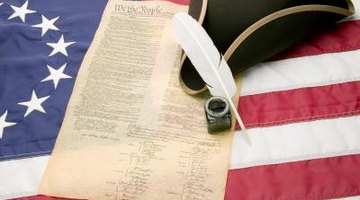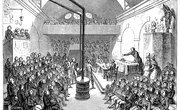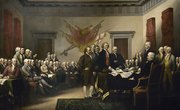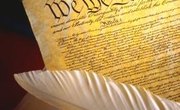The war with the British ended in 1783, but the American Revolution was not complete without a working government. The Continental Congress had proven too weak and inept, and throughout the 1780s, the need for a more effective central government became apparent to the states. To prevent disintegration of the new republic, The Congress called delegates from the states to meet in Philadelphia, Pennsylvania to revise the existing constitution called the Articles of Confederation.
Articles of Confederation
Drafted in 1776 and ratified by 1781, the Articles of Confederation served as the nation's first constitution. Although the document effectively established the United States as a sovereign nation, it proved woefully inadequate. Lacking provision for an executive or judiciary, with no ability to raise revenue and no power to amend the Articles without unanimous state support, the federal government was too weak. The Articles of Confederation served to demonstrate to the delegates what deficiencies especially needed correcting.
The Virginia and New Jersey Plans
Delegates from Virginia and New Jersey introduced frameworks for a new constitution that set the stage for debate during the Convention. Written by James Madison, the Virginia Plan proposed sweeping changes to the Articles.
Most notably was its provision for the checks and balances of three branches of the federal government and a legislature based on state population. The New Jersey Plan called for a legislature comprised of an equal number of delegates from each state.
The Federalists and National Government
Most of the Convention delegates had been major figures during the Revolution and many had served in the Continental Army. They knew first-hand the catastrophic consequences of a weak central government. The army suffered because the government had no power to force resources from the states. Federalist delegates that included Alexander Hamilton convinced the convention of the need for a strong central government.
The Role of the States
Although the delegates agreed to a strong central government, they keenly believed in the preservation of a republic comprised of sovereign states. Delegates from smaller states, such as New Jersey and Connecticut, feared a government dominated by large states such as New York and Virginia.
To counter this, the delegates agreed to a compromise between the Virginia and New Jersey plans: a bicameral legislature with a senate of equal representation and a second body based on state population.
Sectional differences influenced the Convention's process, especially when it came to slavery. States from the South wanted the institution protected by the Constitution. Both Section Nine of Article I and a provision in Article V tabled Congress's ability to interfere with slavery until 1808.
Related Articles
References
Resources
Writer Bio
Charles Hooper began writing as a career in 2009. Since then he has published a nonpartisan political advocacy book and hundreds of articles. An honors graduate from the University of North Carolina at Asheville where he concentrated in sociology and political science, he later earned a Masters degree in social work from the University of North Carolina at Chapel Hill.











